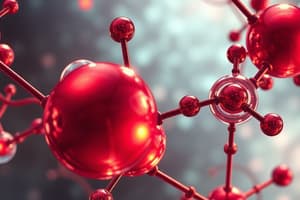Podcast
Questions and Answers
What is the difference between atoms and compounds?
What is the difference between atoms and compounds?
- Atoms are always neutral, while compounds have a charge
- Atoms are only found in nature, while compounds are man-made
- Atoms are made up of a single element, while compounds are made up of two or more elements chemically combined (correct)
- Atoms and compounds are the same thing
What is valency in chemistry?
What is valency in chemistry?
- The number of neutrons in an atom
- The combining power of an element (correct)
- The number of electrons in an atom's outer shell
- The weight of an element
What is the difference between covalent and ionic bonding?
What is the difference between covalent and ionic bonding?
- Covalent bonding only occurs between metals, while ionic bonding only occurs between non-metals
- Covalent bonding involves the transfer of electrons from one atom to another, while ionic bonding involves the sharing of electrons between atoms
- Covalent bonding involves the sharing of electrons between atoms, while ionic bonding involves the transfer of electrons from one atom to another (correct)
- Covalent bonding and ionic bonding are the same thing
Flashcards
What is an atom?
What is an atom?
Atoms are the smallest unit of matter. A single element.
What is a compound?
What is a compound?
A compound is formed when two or more elements bond chemically.
What is valency?
What is valency?
The combining power of an element represents how many atoms of another element it can bond with.
Study Notes
Atoms and Compounds
- Atoms are the smallest units of matter that retain the properties of a chemical element, consisting of protons, neutrons, and electrons.
- Compounds are formed when two or more different atoms chemically bond together, resulting in a new substance with unique properties.
- Atoms in a compound share one or more electrons, whereas atoms in a molecule are held together by covalent bonds.
Valency in Chemistry
- Valency is the combining power of an atom, indicating the number of electrons an atom can gain, lose, or share to form a chemical bond.
- Valency is a measure of an atom's ability to form bonds with other atoms, helping to predict the number of bonds an atom can form.
Covalent and Ionic Bonding
- Covalent bonding occurs when two or more atoms share one or more pairs of electrons to form a molecule, resulting in a shared electron cloud.
- Ionic bonding occurs when one or more electrons are transferred from one atom to another, resulting in the formation of ions with opposite charges.
- Covalent bonds are typically found in molecules, while ionic bonds are typically found in crystalline solids.
- Covalent bonds are stronger than ionic bonds, but ionic bonds can be more stable due to the electrostatic attraction between oppositely charged ions.
Studying That Suits You
Use AI to generate personalized quizzes and flashcards to suit your learning preferences.




